CHCECE017 Foster the Holistic Development and Wellbeing of the Child in Early Childhood
VerifiedAdded on 2023/06/12
|8
|2370
|281
AI Summary
This report discusses the importance of fostering the holistic development and wellbeing of children in early childhood. It covers observing and monitoring development skills, early years learning framework, planning and implementation, range of experiences, and more. The report also includes how to facilitate families' diverse contributions to the learning environment, integration of spontaneous teachable moments, and identification of EYLF outcomes and sub-outcomes met during the experience.
Contribute Materials
Your contribution can guide someone’s learning journey. Share your
documents today.
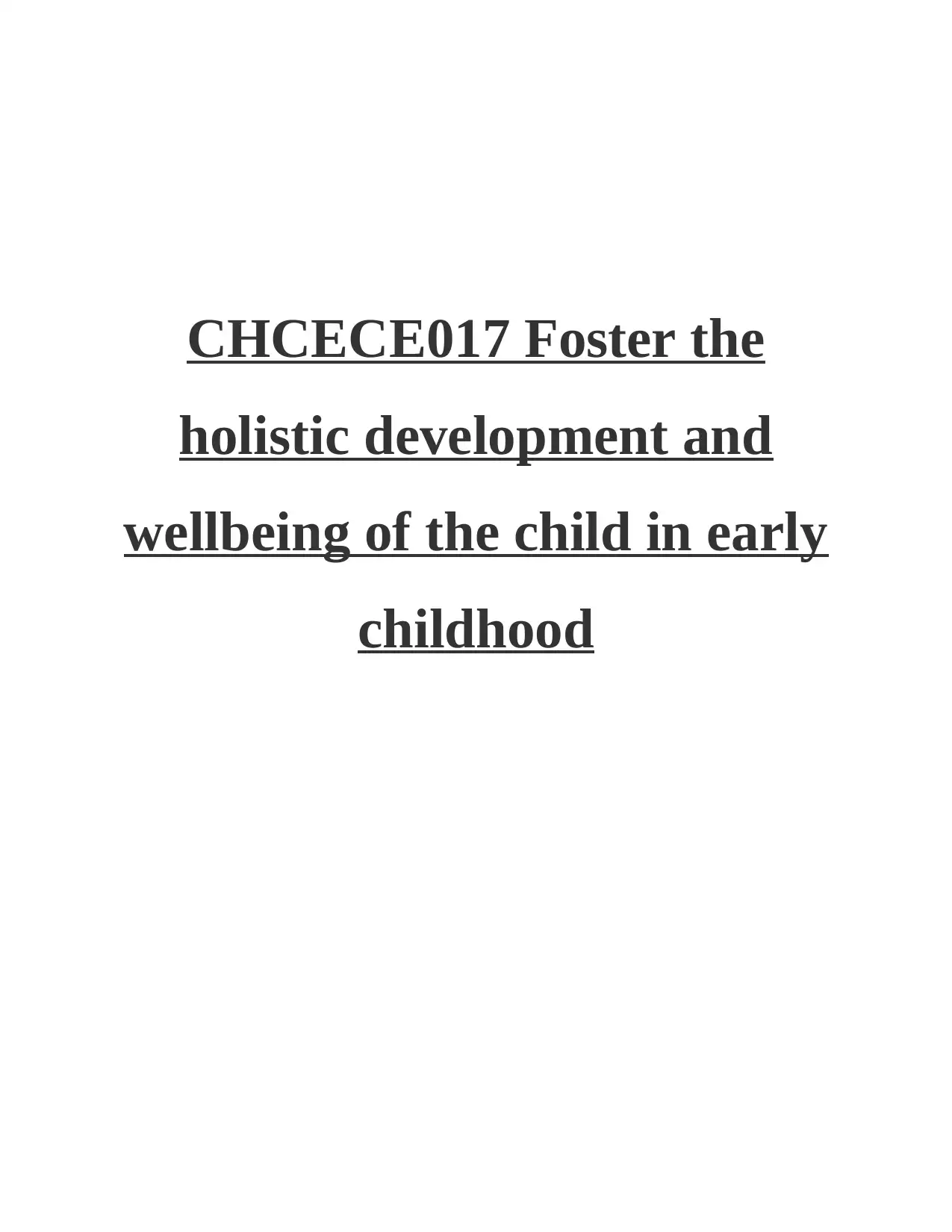
CHCECE017 Foster the
holistic development and
wellbeing of the child in early
childhood
holistic development and
wellbeing of the child in early
childhood
Secure Best Marks with AI Grader
Need help grading? Try our AI Grader for instant feedback on your assignments.
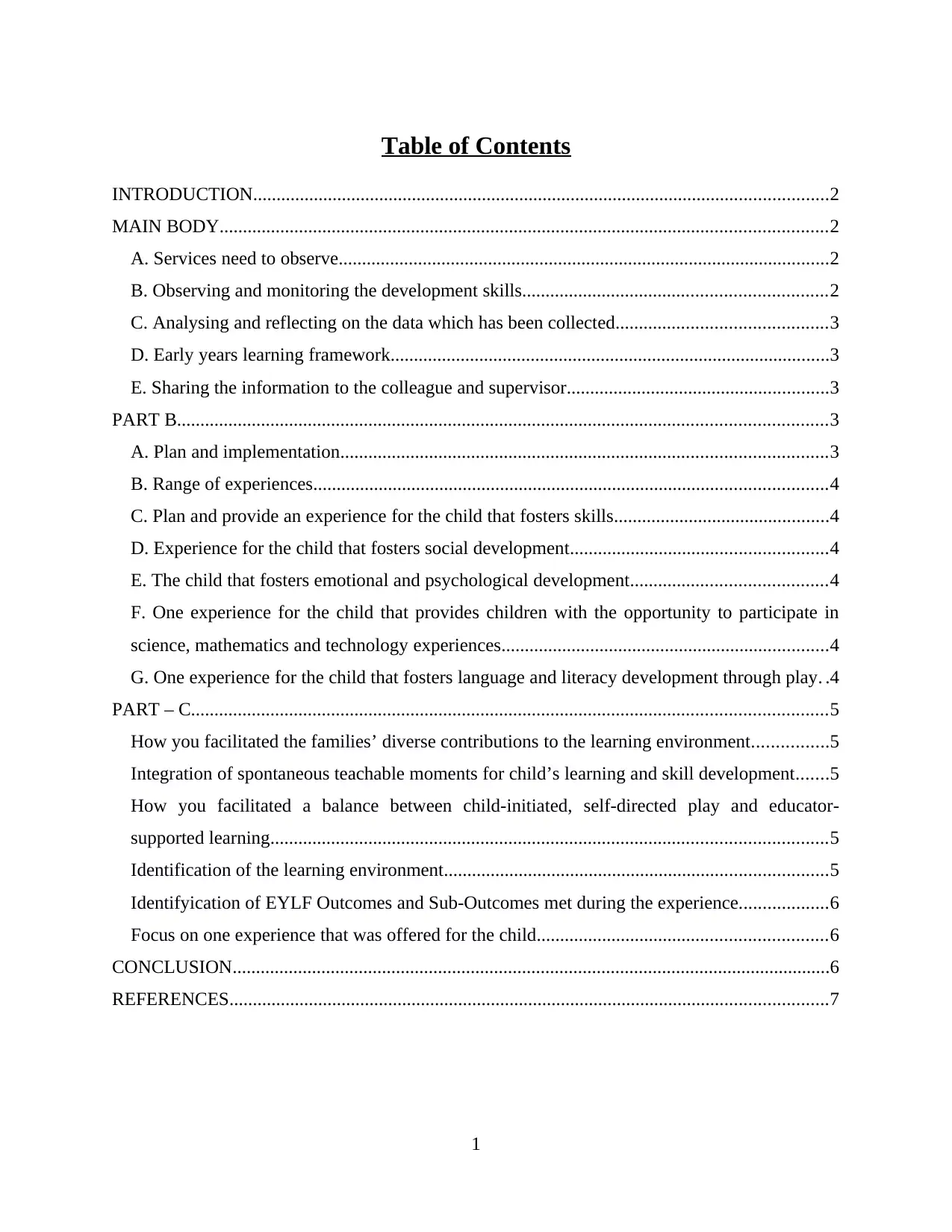
Table of Contents
INTRODUCTION...........................................................................................................................2
MAIN BODY..................................................................................................................................2
A. Services need to observe.........................................................................................................2
B. Observing and monitoring the development skills.................................................................2
C. Analysing and reflecting on the data which has been collected.............................................3
D. Early years learning framework..............................................................................................3
E. Sharing the information to the colleague and supervisor........................................................3
PART B...........................................................................................................................................3
A. Plan and implementation........................................................................................................3
B. Range of experiences..............................................................................................................4
C. Plan and provide an experience for the child that fosters skills..............................................4
D. Experience for the child that fosters social development.......................................................4
E. The child that fosters emotional and psychological development..........................................4
F. One experience for the child that provides children with the opportunity to participate in
science, mathematics and technology experiences......................................................................4
G. One experience for the child that fosters language and literacy development through play. .4
PART – C........................................................................................................................................5
How you facilitated the families’ diverse contributions to the learning environment................5
Integration of spontaneous teachable moments for child’s learning and skill development.......5
How you facilitated a balance between child-initiated, self-directed play and educator-
supported learning.......................................................................................................................5
Identification of the learning environment..................................................................................5
Identifyication of EYLF Outcomes and Sub-Outcomes met during the experience...................6
Focus on one experience that was offered for the child..............................................................6
CONCLUSION................................................................................................................................6
REFERENCES................................................................................................................................7
1
INTRODUCTION...........................................................................................................................2
MAIN BODY..................................................................................................................................2
A. Services need to observe.........................................................................................................2
B. Observing and monitoring the development skills.................................................................2
C. Analysing and reflecting on the data which has been collected.............................................3
D. Early years learning framework..............................................................................................3
E. Sharing the information to the colleague and supervisor........................................................3
PART B...........................................................................................................................................3
A. Plan and implementation........................................................................................................3
B. Range of experiences..............................................................................................................4
C. Plan and provide an experience for the child that fosters skills..............................................4
D. Experience for the child that fosters social development.......................................................4
E. The child that fosters emotional and psychological development..........................................4
F. One experience for the child that provides children with the opportunity to participate in
science, mathematics and technology experiences......................................................................4
G. One experience for the child that fosters language and literacy development through play. .4
PART – C........................................................................................................................................5
How you facilitated the families’ diverse contributions to the learning environment................5
Integration of spontaneous teachable moments for child’s learning and skill development.......5
How you facilitated a balance between child-initiated, self-directed play and educator-
supported learning.......................................................................................................................5
Identification of the learning environment..................................................................................5
Identifyication of EYLF Outcomes and Sub-Outcomes met during the experience...................6
Focus on one experience that was offered for the child..............................................................6
CONCLUSION................................................................................................................................6
REFERENCES................................................................................................................................7
1
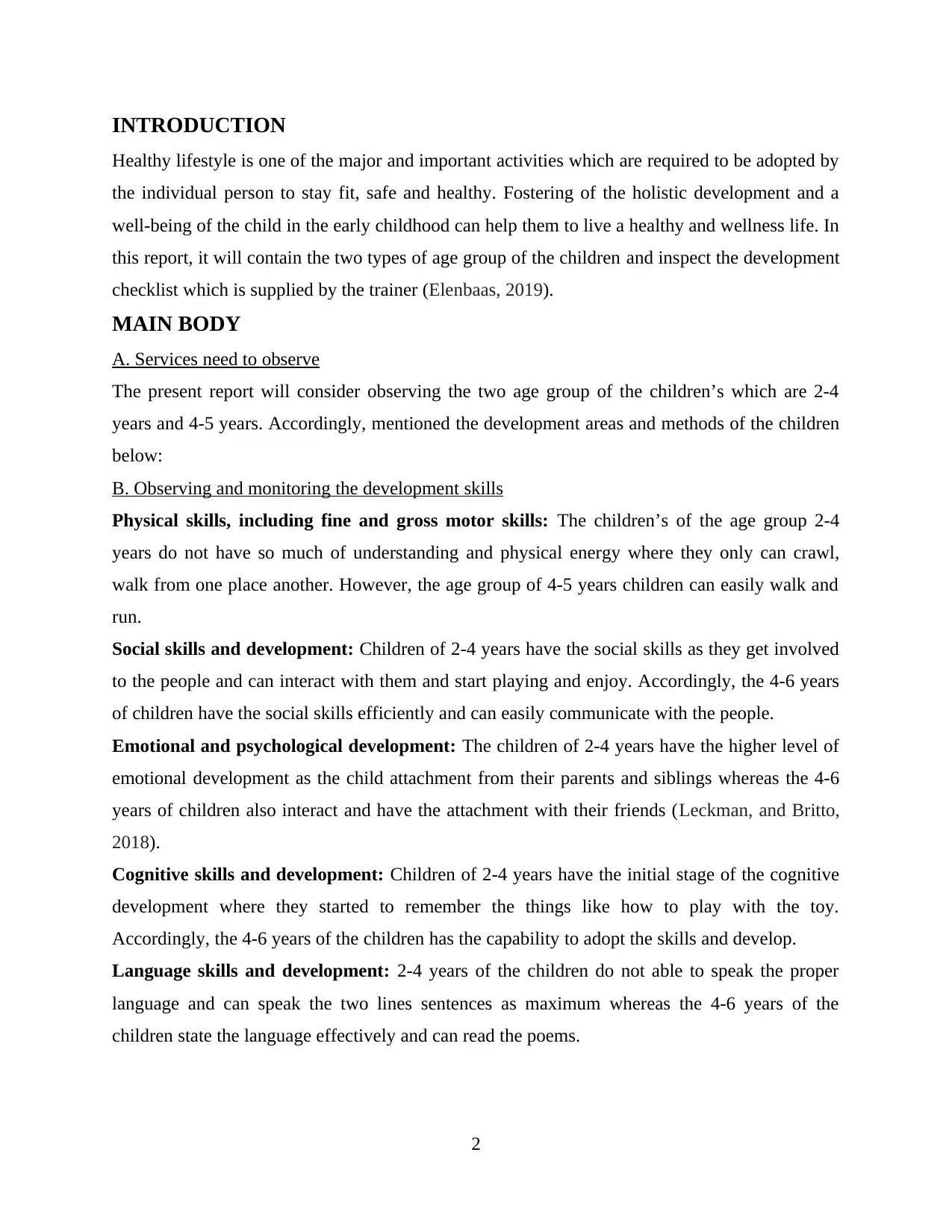
INTRODUCTION
Healthy lifestyle is one of the major and important activities which are required to be adopted by
the individual person to stay fit, safe and healthy. Fostering of the holistic development and a
well-being of the child in the early childhood can help them to live a healthy and wellness life. In
this report, it will contain the two types of age group of the children and inspect the development
checklist which is supplied by the trainer (Elenbaas, 2019).
MAIN BODY
A. Services need to observe
The present report will consider observing the two age group of the children’s which are 2-4
years and 4-5 years. Accordingly, mentioned the development areas and methods of the children
below:
B. Observing and monitoring the development skills
Physical skills, including fine and gross motor skills: The children’s of the age group 2-4
years do not have so much of understanding and physical energy where they only can crawl,
walk from one place another. However, the age group of 4-5 years children can easily walk and
run.
Social skills and development: Children of 2-4 years have the social skills as they get involved
to the people and can interact with them and start playing and enjoy. Accordingly, the 4-6 years
of children have the social skills efficiently and can easily communicate with the people.
Emotional and psychological development: The children of 2-4 years have the higher level of
emotional development as the child attachment from their parents and siblings whereas the 4-6
years of children also interact and have the attachment with their friends (Leckman, and Britto,
2018).
Cognitive skills and development: Children of 2-4 years have the initial stage of the cognitive
development where they started to remember the things like how to play with the toy.
Accordingly, the 4-6 years of the children has the capability to adopt the skills and develop.
Language skills and development: 2-4 years of the children do not able to speak the proper
language and can speak the two lines sentences as maximum whereas the 4-6 years of the
children state the language effectively and can read the poems.
2
Healthy lifestyle is one of the major and important activities which are required to be adopted by
the individual person to stay fit, safe and healthy. Fostering of the holistic development and a
well-being of the child in the early childhood can help them to live a healthy and wellness life. In
this report, it will contain the two types of age group of the children and inspect the development
checklist which is supplied by the trainer (Elenbaas, 2019).
MAIN BODY
A. Services need to observe
The present report will consider observing the two age group of the children’s which are 2-4
years and 4-5 years. Accordingly, mentioned the development areas and methods of the children
below:
B. Observing and monitoring the development skills
Physical skills, including fine and gross motor skills: The children’s of the age group 2-4
years do not have so much of understanding and physical energy where they only can crawl,
walk from one place another. However, the age group of 4-5 years children can easily walk and
run.
Social skills and development: Children of 2-4 years have the social skills as they get involved
to the people and can interact with them and start playing and enjoy. Accordingly, the 4-6 years
of children have the social skills efficiently and can easily communicate with the people.
Emotional and psychological development: The children of 2-4 years have the higher level of
emotional development as the child attachment from their parents and siblings whereas the 4-6
years of children also interact and have the attachment with their friends (Leckman, and Britto,
2018).
Cognitive skills and development: Children of 2-4 years have the initial stage of the cognitive
development where they started to remember the things like how to play with the toy.
Accordingly, the 4-6 years of the children has the capability to adopt the skills and develop.
Language skills and development: 2-4 years of the children do not able to speak the proper
language and can speak the two lines sentences as maximum whereas the 4-6 years of the
children state the language effectively and can read the poems.
2
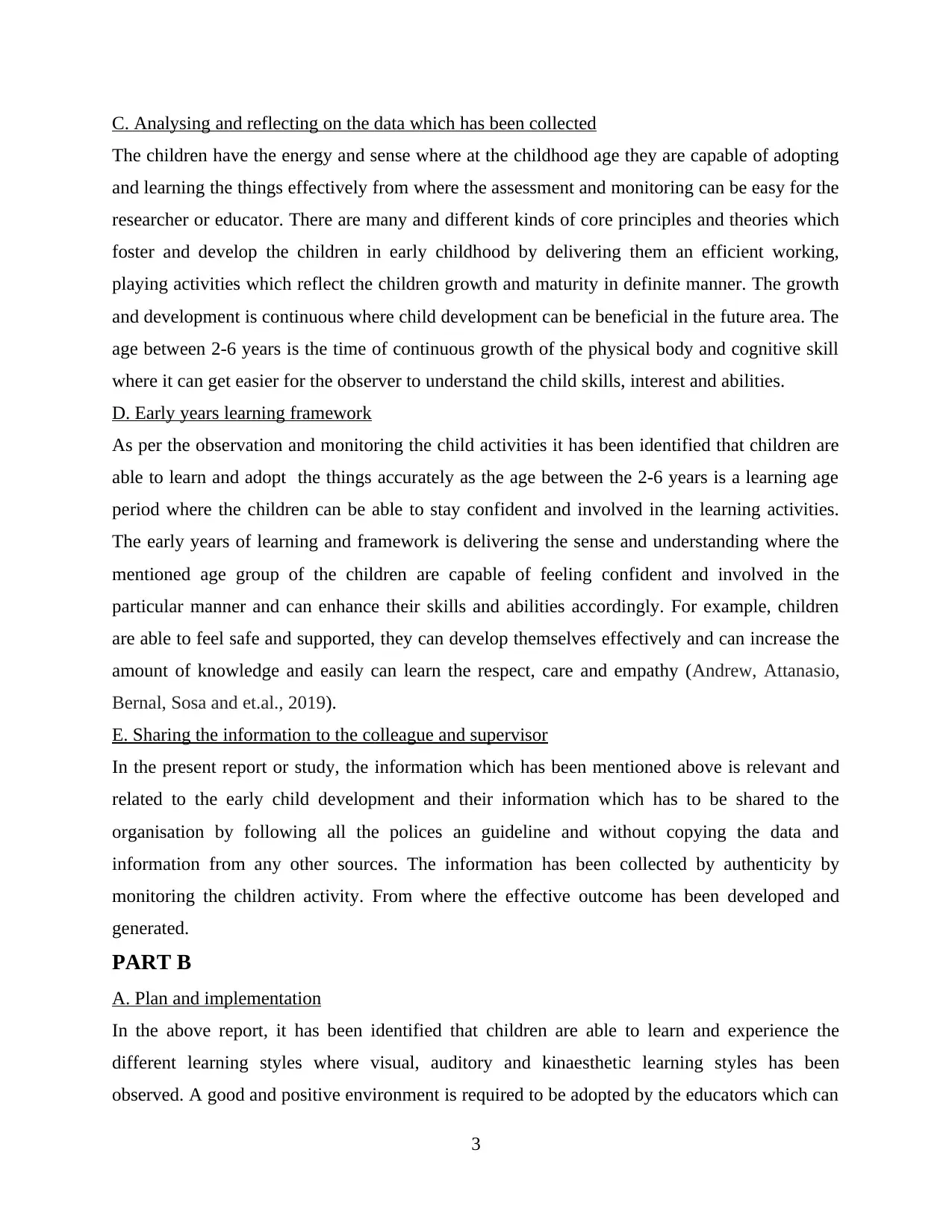
C. Analysing and reflecting on the data which has been collected
The children have the energy and sense where at the childhood age they are capable of adopting
and learning the things effectively from where the assessment and monitoring can be easy for the
researcher or educator. There are many and different kinds of core principles and theories which
foster and develop the children in early childhood by delivering them an efficient working,
playing activities which reflect the children growth and maturity in definite manner. The growth
and development is continuous where child development can be beneficial in the future area. The
age between 2-6 years is the time of continuous growth of the physical body and cognitive skill
where it can get easier for the observer to understand the child skills, interest and abilities.
D. Early years learning framework
As per the observation and monitoring the child activities it has been identified that children are
able to learn and adopt the things accurately as the age between the 2-6 years is a learning age
period where the children can be able to stay confident and involved in the learning activities.
The early years of learning and framework is delivering the sense and understanding where the
mentioned age group of the children are capable of feeling confident and involved in the
particular manner and can enhance their skills and abilities accordingly. For example, children
are able to feel safe and supported, they can develop themselves effectively and can increase the
amount of knowledge and easily can learn the respect, care and empathy (Andrew, Attanasio,
Bernal, Sosa and et.al., 2019).
E. Sharing the information to the colleague and supervisor
In the present report or study, the information which has been mentioned above is relevant and
related to the early child development and their information which has to be shared to the
organisation by following all the polices an guideline and without copying the data and
information from any other sources. The information has been collected by authenticity by
monitoring the children activity. From where the effective outcome has been developed and
generated.
PART B
A. Plan and implementation
In the above report, it has been identified that children are able to learn and experience the
different learning styles where visual, auditory and kinaesthetic learning styles has been
observed. A good and positive environment is required to be adopted by the educators which can
3
The children have the energy and sense where at the childhood age they are capable of adopting
and learning the things effectively from where the assessment and monitoring can be easy for the
researcher or educator. There are many and different kinds of core principles and theories which
foster and develop the children in early childhood by delivering them an efficient working,
playing activities which reflect the children growth and maturity in definite manner. The growth
and development is continuous where child development can be beneficial in the future area. The
age between 2-6 years is the time of continuous growth of the physical body and cognitive skill
where it can get easier for the observer to understand the child skills, interest and abilities.
D. Early years learning framework
As per the observation and monitoring the child activities it has been identified that children are
able to learn and adopt the things accurately as the age between the 2-6 years is a learning age
period where the children can be able to stay confident and involved in the learning activities.
The early years of learning and framework is delivering the sense and understanding where the
mentioned age group of the children are capable of feeling confident and involved in the
particular manner and can enhance their skills and abilities accordingly. For example, children
are able to feel safe and supported, they can develop themselves effectively and can increase the
amount of knowledge and easily can learn the respect, care and empathy (Andrew, Attanasio,
Bernal, Sosa and et.al., 2019).
E. Sharing the information to the colleague and supervisor
In the present report or study, the information which has been mentioned above is relevant and
related to the early child development and their information which has to be shared to the
organisation by following all the polices an guideline and without copying the data and
information from any other sources. The information has been collected by authenticity by
monitoring the children activity. From where the effective outcome has been developed and
generated.
PART B
A. Plan and implementation
In the above report, it has been identified that children are able to learn and experience the
different learning styles where visual, auditory and kinaesthetic learning styles has been
observed. A good and positive environment is required to be adopted by the educators which can
3
Secure Best Marks with AI Grader
Need help grading? Try our AI Grader for instant feedback on your assignments.
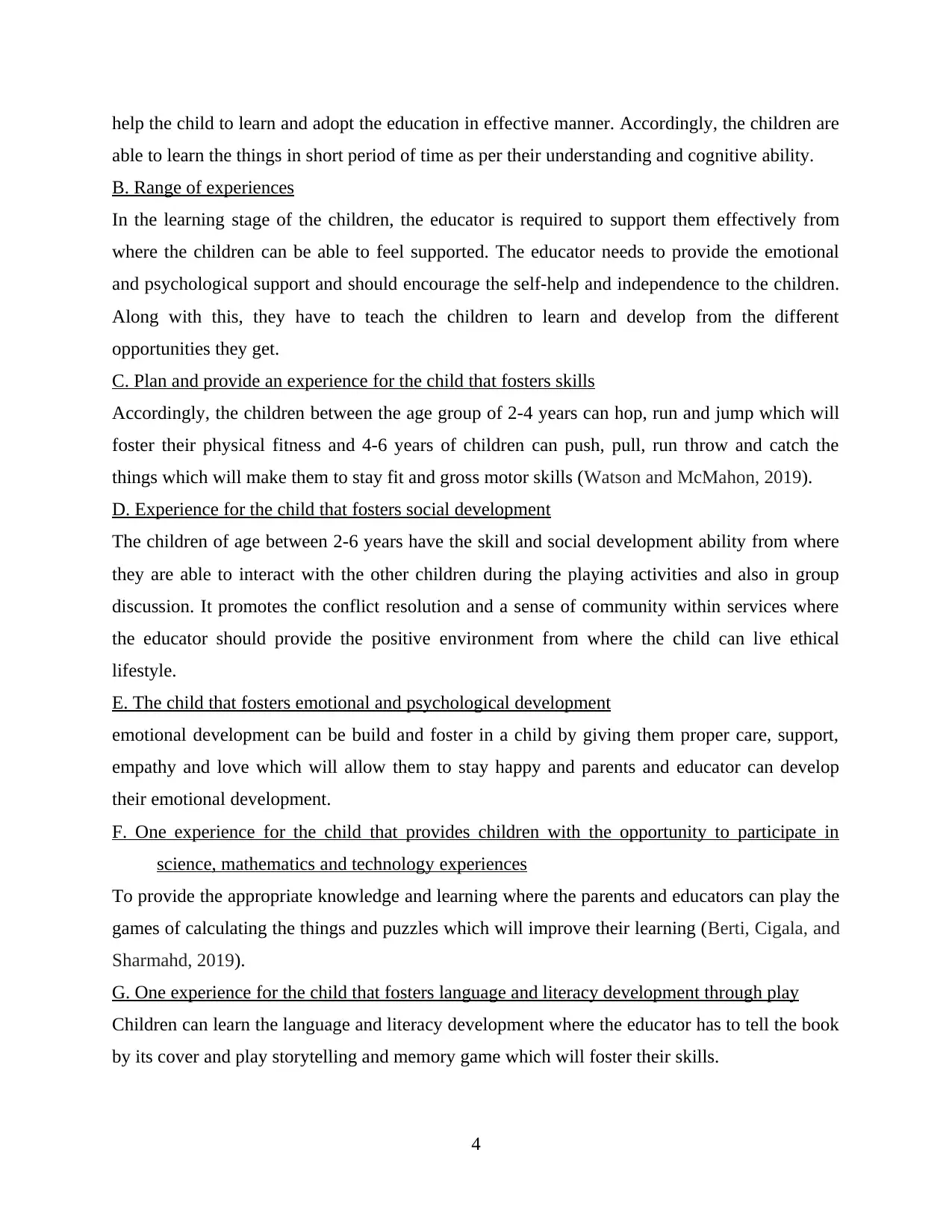
help the child to learn and adopt the education in effective manner. Accordingly, the children are
able to learn the things in short period of time as per their understanding and cognitive ability.
B. Range of experiences
In the learning stage of the children, the educator is required to support them effectively from
where the children can be able to feel supported. The educator needs to provide the emotional
and psychological support and should encourage the self-help and independence to the children.
Along with this, they have to teach the children to learn and develop from the different
opportunities they get.
C. Plan and provide an experience for the child that fosters skills
Accordingly, the children between the age group of 2-4 years can hop, run and jump which will
foster their physical fitness and 4-6 years of children can push, pull, run throw and catch the
things which will make them to stay fit and gross motor skills (Watson and McMahon, 2019).
D. Experience for the child that fosters social development
The children of age between 2-6 years have the skill and social development ability from where
they are able to interact with the other children during the playing activities and also in group
discussion. It promotes the conflict resolution and a sense of community within services where
the educator should provide the positive environment from where the child can live ethical
lifestyle.
E. The child that fosters emotional and psychological development
emotional development can be build and foster in a child by giving them proper care, support,
empathy and love which will allow them to stay happy and parents and educator can develop
their emotional development.
F. One experience for the child that provides children with the opportunity to participate in
science, mathematics and technology experiences
To provide the appropriate knowledge and learning where the parents and educators can play the
games of calculating the things and puzzles which will improve their learning (Berti, Cigala, and
Sharmahd, 2019).
G. One experience for the child that fosters language and literacy development through play
Children can learn the language and literacy development where the educator has to tell the book
by its cover and play storytelling and memory game which will foster their skills.
4
able to learn the things in short period of time as per their understanding and cognitive ability.
B. Range of experiences
In the learning stage of the children, the educator is required to support them effectively from
where the children can be able to feel supported. The educator needs to provide the emotional
and psychological support and should encourage the self-help and independence to the children.
Along with this, they have to teach the children to learn and develop from the different
opportunities they get.
C. Plan and provide an experience for the child that fosters skills
Accordingly, the children between the age group of 2-4 years can hop, run and jump which will
foster their physical fitness and 4-6 years of children can push, pull, run throw and catch the
things which will make them to stay fit and gross motor skills (Watson and McMahon, 2019).
D. Experience for the child that fosters social development
The children of age between 2-6 years have the skill and social development ability from where
they are able to interact with the other children during the playing activities and also in group
discussion. It promotes the conflict resolution and a sense of community within services where
the educator should provide the positive environment from where the child can live ethical
lifestyle.
E. The child that fosters emotional and psychological development
emotional development can be build and foster in a child by giving them proper care, support,
empathy and love which will allow them to stay happy and parents and educator can develop
their emotional development.
F. One experience for the child that provides children with the opportunity to participate in
science, mathematics and technology experiences
To provide the appropriate knowledge and learning where the parents and educators can play the
games of calculating the things and puzzles which will improve their learning (Berti, Cigala, and
Sharmahd, 2019).
G. One experience for the child that fosters language and literacy development through play
Children can learn the language and literacy development where the educator has to tell the book
by its cover and play storytelling and memory game which will foster their skills.
4
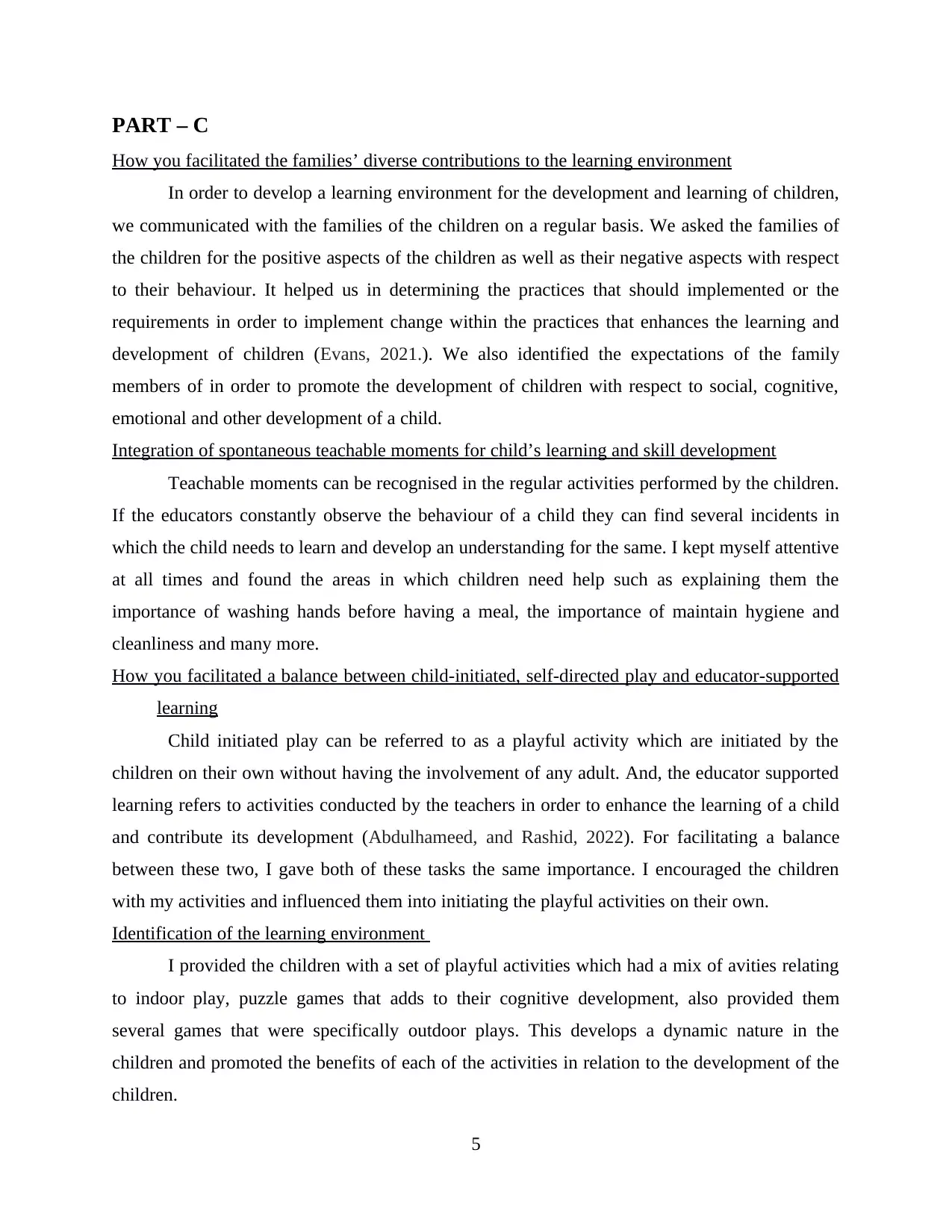
PART – C
How you facilitated the families’ diverse contributions to the learning environment
In order to develop a learning environment for the development and learning of children,
we communicated with the families of the children on a regular basis. We asked the families of
the children for the positive aspects of the children as well as their negative aspects with respect
to their behaviour. It helped us in determining the practices that should implemented or the
requirements in order to implement change within the practices that enhances the learning and
development of children (Evans, 2021.). We also identified the expectations of the family
members of in order to promote the development of children with respect to social, cognitive,
emotional and other development of a child.
Integration of spontaneous teachable moments for child’s learning and skill development
Teachable moments can be recognised in the regular activities performed by the children.
If the educators constantly observe the behaviour of a child they can find several incidents in
which the child needs to learn and develop an understanding for the same. I kept myself attentive
at all times and found the areas in which children need help such as explaining them the
importance of washing hands before having a meal, the importance of maintain hygiene and
cleanliness and many more.
How you facilitated a balance between child-initiated, self-directed play and educator-supported
learning
Child initiated play can be referred to as a playful activity which are initiated by the
children on their own without having the involvement of any adult. And, the educator supported
learning refers to activities conducted by the teachers in order to enhance the learning of a child
and contribute its development (Abdulhameed, and Rashid, 2022). For facilitating a balance
between these two, I gave both of these tasks the same importance. I encouraged the children
with my activities and influenced them into initiating the playful activities on their own.
Identification of the learning environment
I provided the children with a set of playful activities which had a mix of avities relating
to indoor play, puzzle games that adds to their cognitive development, also provided them
several games that were specifically outdoor plays. This develops a dynamic nature in the
children and promoted the benefits of each of the activities in relation to the development of the
children.
5
How you facilitated the families’ diverse contributions to the learning environment
In order to develop a learning environment for the development and learning of children,
we communicated with the families of the children on a regular basis. We asked the families of
the children for the positive aspects of the children as well as their negative aspects with respect
to their behaviour. It helped us in determining the practices that should implemented or the
requirements in order to implement change within the practices that enhances the learning and
development of children (Evans, 2021.). We also identified the expectations of the family
members of in order to promote the development of children with respect to social, cognitive,
emotional and other development of a child.
Integration of spontaneous teachable moments for child’s learning and skill development
Teachable moments can be recognised in the regular activities performed by the children.
If the educators constantly observe the behaviour of a child they can find several incidents in
which the child needs to learn and develop an understanding for the same. I kept myself attentive
at all times and found the areas in which children need help such as explaining them the
importance of washing hands before having a meal, the importance of maintain hygiene and
cleanliness and many more.
How you facilitated a balance between child-initiated, self-directed play and educator-supported
learning
Child initiated play can be referred to as a playful activity which are initiated by the
children on their own without having the involvement of any adult. And, the educator supported
learning refers to activities conducted by the teachers in order to enhance the learning of a child
and contribute its development (Abdulhameed, and Rashid, 2022). For facilitating a balance
between these two, I gave both of these tasks the same importance. I encouraged the children
with my activities and influenced them into initiating the playful activities on their own.
Identification of the learning environment
I provided the children with a set of playful activities which had a mix of avities relating
to indoor play, puzzle games that adds to their cognitive development, also provided them
several games that were specifically outdoor plays. This develops a dynamic nature in the
children and promoted the benefits of each of the activities in relation to the development of the
children.
5
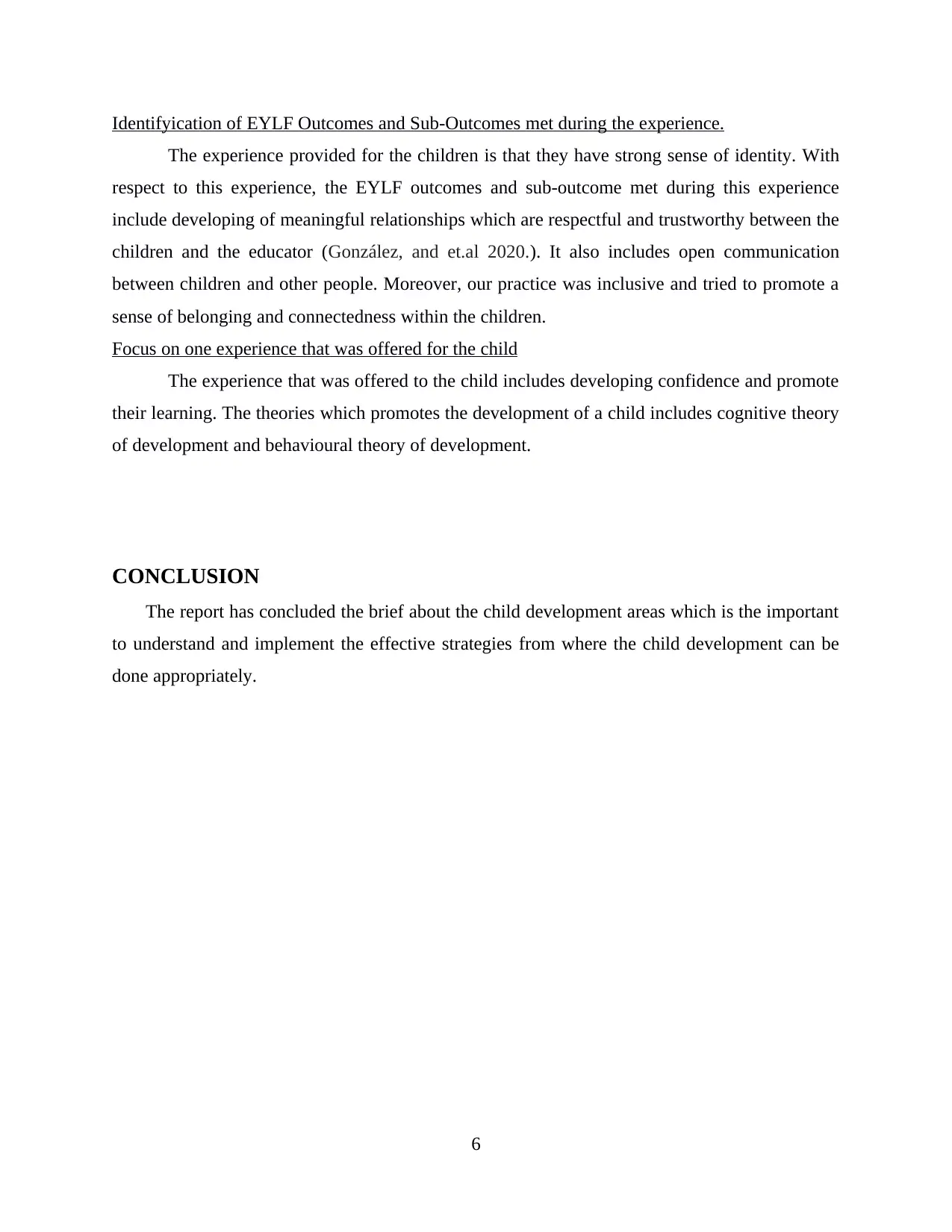
Identifyication of EYLF Outcomes and Sub-Outcomes met during the experience.
The experience provided for the children is that they have strong sense of identity. With
respect to this experience, the EYLF outcomes and sub-outcome met during this experience
include developing of meaningful relationships which are respectful and trustworthy between the
children and the educator (González, and et.al 2020.). It also includes open communication
between children and other people. Moreover, our practice was inclusive and tried to promote a
sense of belonging and connectedness within the children.
Focus on one experience that was offered for the child
The experience that was offered to the child includes developing confidence and promote
their learning. The theories which promotes the development of a child includes cognitive theory
of development and behavioural theory of development.
CONCLUSION
The report has concluded the brief about the child development areas which is the important
to understand and implement the effective strategies from where the child development can be
done appropriately.
6
The experience provided for the children is that they have strong sense of identity. With
respect to this experience, the EYLF outcomes and sub-outcome met during this experience
include developing of meaningful relationships which are respectful and trustworthy between the
children and the educator (González, and et.al 2020.). It also includes open communication
between children and other people. Moreover, our practice was inclusive and tried to promote a
sense of belonging and connectedness within the children.
Focus on one experience that was offered for the child
The experience that was offered to the child includes developing confidence and promote
their learning. The theories which promotes the development of a child includes cognitive theory
of development and behavioural theory of development.
CONCLUSION
The report has concluded the brief about the child development areas which is the important
to understand and implement the effective strategies from where the child development can be
done appropriately.
6
Paraphrase This Document
Need a fresh take? Get an instant paraphrase of this document with our AI Paraphraser
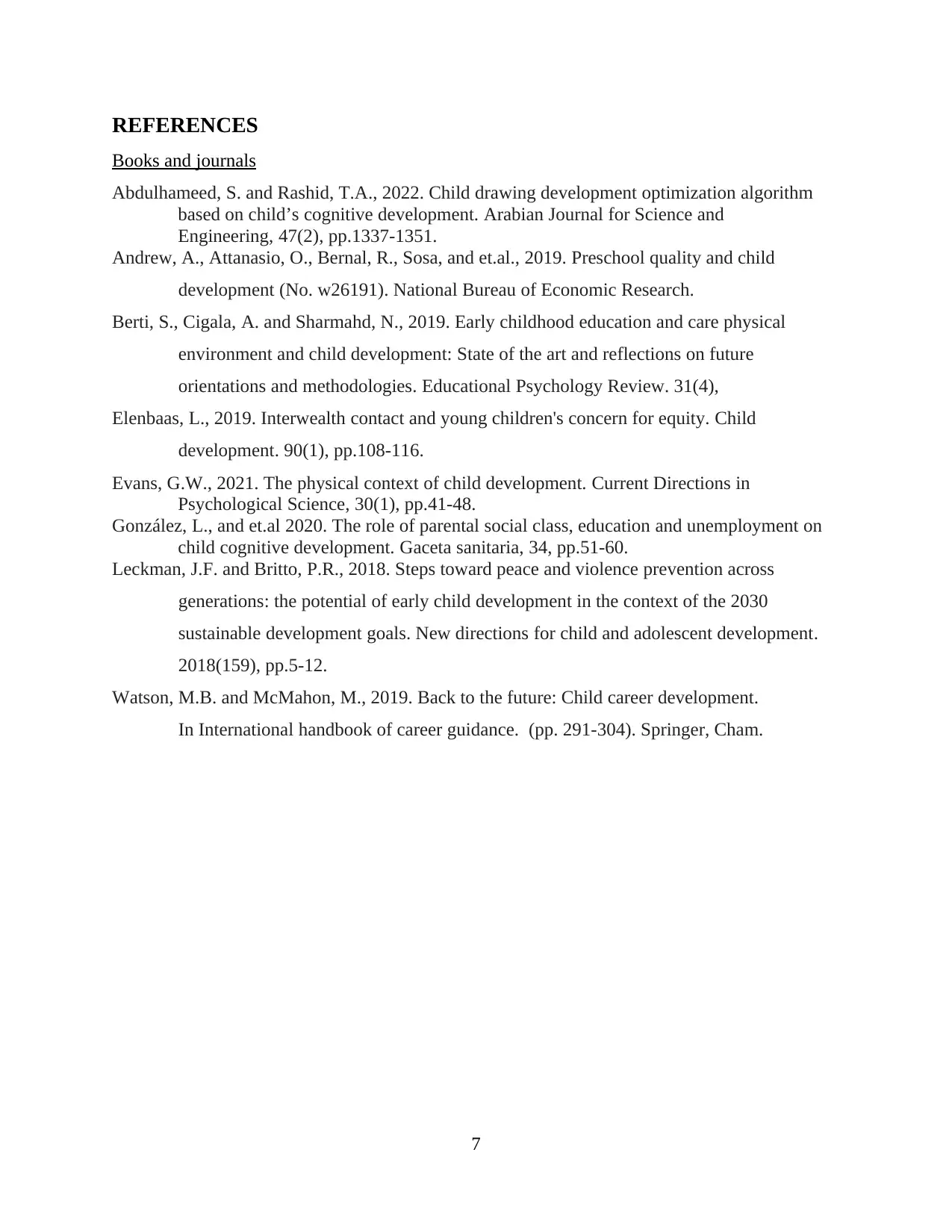
REFERENCES
Books and journals
Abdulhameed, S. and Rashid, T.A., 2022. Child drawing development optimization algorithm
based on child’s cognitive development. Arabian Journal for Science and
Engineering, 47(2), pp.1337-1351.
Andrew, A., Attanasio, O., Bernal, R., Sosa, and et.al., 2019. Preschool quality and child
development (No. w26191). National Bureau of Economic Research.
Berti, S., Cigala, A. and Sharmahd, N., 2019. Early childhood education and care physical
environment and child development: State of the art and reflections on future
orientations and methodologies. Educational Psychology Review. 31(4),
Elenbaas, L., 2019. Interwealth contact and young children's concern for equity. Child
development. 90(1), pp.108-116.
Evans, G.W., 2021. The physical context of child development. Current Directions in
Psychological Science, 30(1), pp.41-48.
González, L., and et.al 2020. The role of parental social class, education and unemployment on
child cognitive development. Gaceta sanitaria, 34, pp.51-60.
Leckman, J.F. and Britto, P.R., 2018. Steps toward peace and violence prevention across
generations: the potential of early child development in the context of the 2030
sustainable development goals. New directions for child and adolescent development.
2018(159), pp.5-12.
Watson, M.B. and McMahon, M., 2019. Back to the future: Child career development.
In International handbook of career guidance. (pp. 291-304). Springer, Cham.
7
Books and journals
Abdulhameed, S. and Rashid, T.A., 2022. Child drawing development optimization algorithm
based on child’s cognitive development. Arabian Journal for Science and
Engineering, 47(2), pp.1337-1351.
Andrew, A., Attanasio, O., Bernal, R., Sosa, and et.al., 2019. Preschool quality and child
development (No. w26191). National Bureau of Economic Research.
Berti, S., Cigala, A. and Sharmahd, N., 2019. Early childhood education and care physical
environment and child development: State of the art and reflections on future
orientations and methodologies. Educational Psychology Review. 31(4),
Elenbaas, L., 2019. Interwealth contact and young children's concern for equity. Child
development. 90(1), pp.108-116.
Evans, G.W., 2021. The physical context of child development. Current Directions in
Psychological Science, 30(1), pp.41-48.
González, L., and et.al 2020. The role of parental social class, education and unemployment on
child cognitive development. Gaceta sanitaria, 34, pp.51-60.
Leckman, J.F. and Britto, P.R., 2018. Steps toward peace and violence prevention across
generations: the potential of early child development in the context of the 2030
sustainable development goals. New directions for child and adolescent development.
2018(159), pp.5-12.
Watson, M.B. and McMahon, M., 2019. Back to the future: Child career development.
In International handbook of career guidance. (pp. 291-304). Springer, Cham.
7
1 out of 8
Related Documents
Your All-in-One AI-Powered Toolkit for Academic Success.
+13062052269
info@desklib.com
Available 24*7 on WhatsApp / Email
![[object Object]](/_next/static/media/star-bottom.7253800d.svg)
Unlock your academic potential
© 2024 | Zucol Services PVT LTD | All rights reserved.



